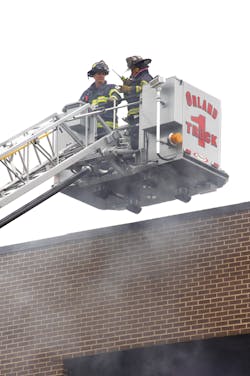Downsides were highlighted in a national news article released last week by the McClatchy News Service, including noise distortion and claims that the technology has contributed toward firefighter deaths and close calls.
However, Firehouse communications expert and columnist Charles Werner says not all factors were presented in the article.
"I think the digital technology issue is kind of a multi fold issue," he said.
"We did discover there is an issue of noise distortion in some environments. Also, there are some best practices procedures that should be followed and weren't. So there are some technical issues and some behavioral issues."
Chief Charles L. Werner of the Charlottesville, Va. Fire Department has been involved with the efforts toward studying this technology as well as creating a nationwide, wireless communications network through several national groups.
Motorola could not address the comments about deaths and close calls due to pending litigation.
A NIOSH report on a double firefighter fatality referenced in the McClatchy article showed radio communication problems as one of five factors in the incident, along with incomplete size-up; disorientation; fire being well-involved before arrival; and potential fire growth from natural gas.
NIOSH's list of recommendations related to this incident included the following:
- Recommendation #4: Fire departments should ensure that radio operability guidelines follow best practices recommended by the International Association of Fire Chiefs.
- Recommendation #9: First responder radio manufacturers, research/design facilities and standard setting bodies should continue research and efforts to improve radio system capabilities.
- Recommendation #10: First responder radio manufacturers, research/design facilities and standard setting bodies should continue research and efforts to refine existing and develop new technology to track the movement of fire fighters inside structures.
Motorola notes that in the years since the reported incidents, it has expanded its outreach to the fire service for feedback and testing, has worked with the fire service to improve training on the technology, and has improved audio with software to enhance noise reduction, as well as dual microphone technology to suppress background noise for better voice intelligibility.
"I think the future of radio communication is going to be digital -- so we need to make sure the fire service is involved so the format meets a quality that is acceptable," Werner said. "We've got to be involved in that process to demand that the quality of voice intelligibility be maintained."
Motorola says it agrees with the need to communicate with the fire service.
"One of the things we try to do with all of our fire products, is realize when designing for the fire market -- we have to go out and talk to firefighters and have them tell us what they need," said Mike Petersen, product management team director.
Petersen said Motorola radios look dramatically different from others on the market because firefighters told them they wanted certain features, whether using the products as analog or digital (as they do both) such as a display on top, loud audio and easy controls.
In Motorola's newest line, the dual microphone technology works with a microphone on each side of the radio, to pick up a voice from either side and use the second to suppress background noise. The new software provides the enhanced algorithm to reduce the impact of noise, and the radio breaks noise up using "adaptive beam forming" to do very fast and continuous monitoring.
To get this product feedback, Motorola visits training facilities, holds forums at fire service industry events, and now works regularly with the IAFF.
"We're continuously looking at new ways to enhance the audio," Petersen said. Motorola is also working with manufacturers on better integration with the rest of a firefighter's gear, such as the SCBA mask and its microphone system.
For future products, Motorola is working toward utilizing digital technology get information about firefighters to the command center, such as physiological monitoring and indoor location, Petersen said.
In addition, to help firefighters currently, Motorola helped sponsor a training video with the IAFC on how to use the technology to make sure departments are getting the best signal possible.
About the Author

Heather Caspi
Managing Editor, News Team
Heather Caspi is an associate editor at EMSWorld.com and has been with Cygnus Business Media since 2000, serving various roles with all three public safety sites. She graduated from the University of Maryland with degrees in Journalism and English Language and Literature, and earned her EMT-B through Merritt College and the Oakland Fire Department in Oakland, California.
